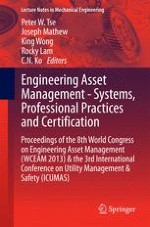This proceeding represents state-of-the-art trends and developments in the emerging field of engineering asset management as presented at the Eight World Congress on Engineering Asset Management (WCEAM). The Proceedings of the WCEAM 2013 is an excellent reference for practitioners, researchers and students in the multidisciplinary field of asset management, covering topics such as:
Asset condition monitoring and intelligent maintenance, 2. Asset data warehousing, data mining and fusion, 3. Asset performance and level-of-service models, 4. Design and life-cycle integrity of physical assets, 5. Deterioration and preservation models for assets, 6. Education and training in asset management, 7. Engineering standards in asset management, 8. Fault diagnosis and prognostics, 9. Financial analysis methods for physical assets, 10. Human dimensions in integrated asset management, 11. Information quality management, 12. Information systems and knowledge management, 13. Intelligent sensors and devices, 14. Maintenance strategies in asset management, 15. Optimisation decisions in asset management, 16. Risk management in asset management, 17. Strategic asset management, 18. Sustainability in asset management.
King WONG served as Congress Chair for WCEAM 2013 and ICUMAS 2013 is the President of the Hong Kong Institute of Utility Specialists (HKIUS) and Convener of International Institute of Utility Specialists (IIUS). Peter TSE is the Director of the Smart Engineering Asset Management laboratory (SEAM) at the City University of Hong Kong and served as the Chair of WCEAM 2013 Organising Committee. Joseph MATHEW served as the Co-Chair of WCEAM 2013 is also WCEAM’s General Chair. He is the Chief Executive Officer of Asset Institute, Australia.
